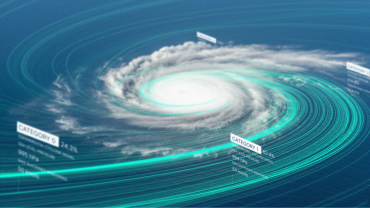
DeepMind AI Predicts Hurricane Paths Week Ahead of Traditional Models
6 minute read

DeepMind’s GraphCast AI Delivers Week-Early Hurricane Predictions While Using Minimal Computing Power
Three Key Facts
- DeepMind’s GraphCast AI model outperformed traditional forecasting systems on 99.7% of tropospheric variables and delivered hurricane track predictions 12 hours faster than the US Global Weather Forecast System
- The AI system successfully predicted Hurricane Beryl’s landfall in Texas nearly a week before conventional models during the 2024 hurricane season, demonstrating superior real-world accuracy
- DeepMind partnered with the U.S. National Hurricane Center to integrate experimental AI predictions into operational forecasting for the first time in weather prediction history
Introduction
Google DeepMind transforms hurricane forecasting with an artificial intelligence system that accurately predicted Hurricane Beryl’s path to Texas nearly a week before traditional models caught up. The breakthrough addresses decades-old challenges in tropical cyclone prediction, marking the first time experimental AI predictions integrate into official weather forecasting operations.
The AI system, called GraphCast, delivers both path and intensity forecasts simultaneously while generating predictions in under a minute. This represents a significant advancement over current models that typically provide either global path predictions or regional intensity forecasts, but not both with high accuracy.
Key Developments
DeepMind launches Weather Lab, an interactive platform that generates 50 storm scenarios up to 15 days ahead. The system draws effectiveness from extensive datasets covering nearly 5,000 historical cyclone events and employs Functional Generative Networks for precise forecast ensembles.
The AI model produces 15-day forecasts in approximately one minute on compact hardware. GraphCast can generate a 10-day weather prediction in under a minute on a machine that researchers describe as “bigger than a laptop, but you can hold it in your hands.”
Hurricane track forecasting has improved dramatically over decades, with three-day forecasts averaging 520 miles off target in 1970 compared to one-tenth of that distance today. DeepMind’s system builds on this progress by averaging five-day forecasts 140 kilometers closer to actual storm positions compared to leading European models.
Market Impact
The global weather forecasting services market projects growth to over $3 billion by 2027. DeepMind’s superior forecasting tools position the company to capture significant value from governments, insurers, agriculture, logistics, and energy sectors that depend on accurate weather predictions.
AI weather models require less computational power and fewer human resources than traditional numerical models, creating lower operational costs and higher scalability. This efficiency advantage allows the system to meet National Hurricane Center deadlines while reducing resource requirements.
Leading weather organizations adopt AI approaches based on DeepMind’s success. The European Centre for Medium-Range Weather Forecasts borrowed DeepMind’s methodology to produce its own AI model, which now edges out their conventional forecasting system.
Strategic Insights
The partnership with the National Hurricane Center represents a crucial endorsement of AI’s role in weather forecasting. Keith Battaglia, DeepMind’s weather team senior director, describes the evolution from casual discussions to formal cooperation that will integrate AI predictions into official guidance during the 2025 Atlantic hurricane season.
DeepMind addresses major limitations in current forecasting by providing simultaneous solutions for both path and intensity predictions. The AI surpasses NOAA’s Hurricane Analysis and Forecast System in intensity forecasting, a notable achievement given AI models’ historical struggles in this area.
The system faces challenges with extreme weather predictions due to limited training data for rare events. GraphCast tends to under-predict wind speeds because it averages conflicting predictions, leading AI systems to forecast lower intensity estimates rather than risk higher, potentially incorrect results.
Expert Opinions and Data
Ferran Alet, a DeepMind research scientist, emphasizes the significance of the intensity forecasting breakthrough by stating, “This is the first AI model that we are now very skillful as well on tropical cyclone intensity.” The model demonstrated superior performance in both Atlantic and Pacific hurricane basins over five-day forecasting periods from 2021 to 2024.
According to VentureBeat, the initiative includes partnerships that mark the first incorporation of experimental AI predictions into operational forecasting. This collaboration represents a pivotal moment in using AI for weather forecasting applications.
Dr. Kate Musgrave from Colorado State University independently evaluated the model, noting its promising performance that matches or exceeds current forecasting systems. This independent validation proves critical as the AI system undergoes real-time testing during the 2025 hurricane season.
Meteorologists like Matt Lanza recognize AI’s capacity to match traditional physics-based models in accuracy. The technology shows particular promise as climate change potentially increases cyclone impact, making improved predictive accuracy essential for protecting coastal regions worldwide.
Navid Tahvildari, a coastal engineering expert, explores AI applications in flood forecasting that complement hurricane predictions. AI models present advantages including speed and efficiency, enabling operation on personal laptops while producing forecasts in seconds at street-level resolution.
Conclusion
DeepMind’s AI system successfully transitions from research to practical application as it begins outperforming traditional forecasting models in real-world conditions. The technology demonstrates particular strength in hurricane track prediction while showing improvement in intensity forecasting, historically a challenging area for AI systems.
Weather Lab provides over two years of past predictions for expert analysis, evidenced by accurate forecasts during significant events like Hurricane Otis in 2023. The platform serves as a research tool while official meteorological agencies continue providing recommended public forecasts.
The advancement represents a significant step toward integrating AI into critical weather prediction infrastructure. Feedback from agencies and services will continue refining AI implementation as the technology undergoes ongoing validation through partnership with the National Hurricane Center.








